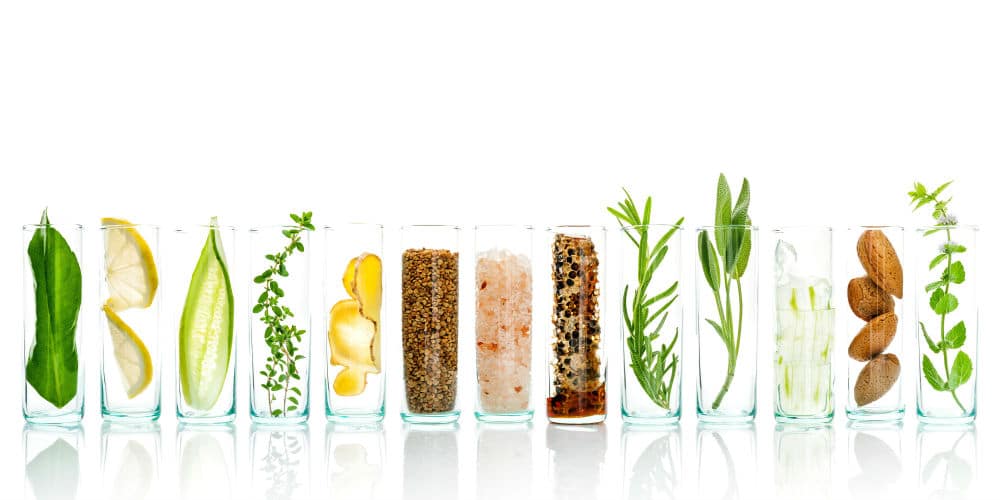You’ve likely used rosemary (Rosmarinus officinalis) in your own kitchen (or tasted it in a restaurant meal if you don’t cook). After all it is one of the most commonly used herbs worldwide for cooking. But did you know that rosemary essential oil is considered one of the most powerful essential oils in the world with a multitude of health-promoting benefits? Rosemary has shown to be hepatoprotective (protective to the liver), and to have anti-diabetic, anti-microbial, anti-inflammatory, antioxidant and anticancer properties.
The name rosemary comes from the Latin words “Ros” meaning dew or mist, and “marinus” meaning sea. Wild rosemary often grows on the sea cliffs in Spain, France, Greece, and Italy. Together with lavender, basil, oregano, and a few other herbs, it is part of the mint family. While you may have a small pot of rosemary on your windowsill, it is a perennial bush that outside can grow to be five feet high. Rosemary grows best in temperate climates where the temperature doesn’t dip below zero degrees Fahrenheit (-17 degrees Celsius).
Rosemary Has Been Valued Through the Ages
Long considered to be advantageous for memory improvement, ancient Greek students wore garlands of rosemary on their heads when studying. The Greeks and Romans used rosemary as a part of almost all festivals and feasts − it was a reminder of the cycle of life and death.
Charlemagne, who ruled a wide area of Western Europe from 768-814, thought so highly of rosemary that he ordered it to be grown on his farms.
Hildegard of Bingen (1098-1179), German abbess, musician, herbalist, and healer (among other accomplishments) wrote several medical texts describing the action of various herbs. Rosemary is amongst those she studied and wrote about.
Rosemary was used in traditional Turkish folk medicine to treat hyperglycemia and indeed, modern research is finding that it may have applications for diabetes.
During the time when the Black Death (bubonic plague) raged in the mid-1300s, branches of rosemary were scattered on the floors and doorways of homes to help ward off the disease. Rosemary was also part of something called “Marseilles Vinegar” or “Four Thieves Vinegar.” This was used by thieves and grave robbers to protect themselves against the plague as they went about the grisly but lucrative business of robbing the dead.
Rosemary was often used as a disinfectant to kill germs in the 16th century, although people of that time didn’t understand the concept of germs. They just knew that if rosemary was burned in the sickroom or applied as a balm or an oil to a sick person, they tended to get better quickly. Paracelsus, a notable physician, philosopher, and herbalist in the 16th century, considered rosemary an essential component in his medicines.
Have you ever been to a funeral and someone handed you a sprig of rosemary to wear? This is a long-held tradition which is meant to indicate that the loved one who has passed will not be forgotten. It dates back to ancient Roman and Greek times when rosemary was tossed into the grave as a sign of remembrance.
Disease-Fighting Phytochemicals in Rosemary Essential Oil
Rosemary essential oil contains some very potent phytochemicals (natural, plant based chemicals) which are steam distilled from the needle-like leaves of the plant. It takes 100 pounds (45.3 kg) of rosemary to yield one pound (453 grams) of essential oil.
Somewhere between 400-500 phytochemicals have been found in rosemary essential oil, making it an exceptional source of different bioactive compounds. The major constituents are 1,8-Cineole, camphor, alpha-pinene, beta-pinene, camphene, borneol, betulinic acid, limonene, carnosic acid, carnosol, rosmanol, and rosmarinic acid. While these names might not sound like much, each one translates into potential benefits for your health.
The 6 Best Health Uses for Rosemary Essential Oil (including Fighting Cancer!)
Modern research is discovering that rosemary has some very important applications for our health. Here is a rundown on six of its most impressive uses and benefits:
- Decreases Cortisol Levels. A small 2007 study published in Psychiatry Researchby Japanese researchers found that five minutes of breathing in rosemary and lavender helped to decrease salivary cortisol levels in 22 healthy volunteers. Cortisol, released in response to stress by the adrenal glands, is sometimes referred to as the “stress hormone.” These same researchers also observed that the antioxidants in both rosemary and lavender essential oils enhanced the body’s free radical scavenging ability.
- Inhibits Deadly Bacteria. Rosemary has long been used to improve skin by fighting bacteria and by cell renewal. A 2016 study done by Egyptian researchers appearing in Journal of Photochemistry and Photobiologyfound that rosemary essential oil was able to significantly inhibit Pseudomonas aeruginosa. This is a gram-negative, multi-drug resistant pathogen associated with serious illnesses like ventilator-associated pneumonia and other sepsis conditions. Also, a 2015 study done by Brazilian researchers, released in Frontiers in Microbiolog found that both rosemary and oregano essential oils had strong antimicrobial activity against Staphylococcus aureus. This is another deadly bacterium, better known as golden staph, also considered to be multi-drug resistant.
A study reported in 2012 by Chinese researchers, published in the journal Molecules, looked at the antibacterial activity of rosemary essential oil. They examined the main constituents of the oil − 1,8-cineole, alpha-pinene and beta-pinene − and compared the antibacterial activity of each constituent to the action of rosemary as a whole. They found that the whole essential oil was more powerful than the constituents on their own (no surprise really!).
- Reduces Inflammation. A 2000 Brazilian study found that 1,8-Cineole has anti-inflammatory and anti-nociceptive (this means it reduces sensitivity to painful stimuli) properties. A 2008 animal study by Slovakian researchers reported in Acta Veterinaria Brnoalso found that rosemary essential oil has anti-inflammatory benefits. Further, a 2011 Iranian animal study found that rosemary essential oil has anti-inflammatory properties and could be considered a possible remedy for colitis, an inflammatory bowel disease.
- Fights Cancer. Dozens of research studies have been done on rosemary for its various phytochemicals and applications for cancer. One American study in particular on carnosol, appearing in the June 2011 edition of Cancer Letters, stated that carnosol appeared to be well tolerated in animal studies and that it has selective toxicity toward cancer cells versus healthy cells.
- Liver Cancer: A 2014 study published in Interdisciplinary Toxicologyby Slovakian researchers found that rosemary oil has anticancer activity in hepatocellular carcinoma (liver cancer), the fifth most common cancer in the world. In addition, joint Saudi and Egyptian research published in 2016 in Pharmaceutical Biology found that rosemary extract has protective effects against hepatotoxicity (toxic effects of chemical drugs on the liver) caused by cyclophosphamide, a commonly used chemotherapy drug.
- Colon Cancer: A 2015 Spanish study published in Food and Chemical Toxicologyon rosemary leaf extract found that it has antiproliferative activity in human colon cancer cells. (This describes the ability of the compound to stop cancer cells from spreading.) A 2016 joint study by Spanish and Swedish researchers appearing in the June 2016 issue of Journal of Proteome Research also found rosemary extracts to have antiproliferative properties against human colon cancer cells.
- Breast Cancer: Joint American and Spanish research published in 2015 in the European Journal of Medicinal Chemistryfound that carnosol (one of the phytochemicals in rosemary) has potent anticancer activity against triple negative breast cancer (TNBC). TNBC is so named because cells of this type of breast cancer do not contain receptors for estrogen, progesterone, or the HER2 protein. Also, an American study released in 2012, appearing in the journal Fitoterapia, found that carnosic acid (another of the phytochemicals in rosemary) displayed significant inhibitory activity in several different ways against estrogen-receptor negative breast cancer cells. Interestingly, the researchers also mentioned a special synergy between rosemary and curcumin which is found in turmeric.
- Skin Cancer: Italian research published in 2015 in the Journal PLoS Onefound that rosemary had an anti-proliferative effect on human melanoma (malignant skin cancer) cells. Researchers said rosemary “drastically” reduced melanoma cell growth and metabolic activity.
- Adult T-cell Leukemia/Lymphoma: A 2014 Japanese study appearing in the journal Human Cell[20] found that carnosol (one of the phytochemicals in rosemary) induced apoptosis (planned cell death, a feature missing in cancer cells) in adult T-cell leukemia/lymphoma cells.
- Lung Cancer: An extract of rosemary was examined for its role in proliferation, survival, and apoptosis of human non-small cell lung cancer cells. Canadian researchers found rosemary to have “considerable anti-tumor and chemopreventive properties in lung cancer.”The study was reported in Biomedicine & Pharmacotherapy in July 2016.
- Aids Hair Regrowth. Rosemary has been used traditionally for combatting hair loss. Researchers, comparing it with minoxidil (a commonly used drug for combating hair loss) found rosemary essential oil to be just as good as minoxidil(after 6 months of use). The study was released in 2015 in the journal SkinMed.
- Assists Brain Health. Rosemary has long been revered for its ability to help overcome mental fatigue, improving mental clarity and focus. Now, Japanese researchers have shown that rosemary can do more than that. The research, published in 2015 in Neuroscience Researchstated that carnosic acid (one of rosemary’s phytochemicals) has neuroprotective functions in brain cells. They said carnosic acid “served as an activator for neuroprotective and neurotrophic functions in brain cells.” They also stated it may be helpful in the prevention of Alzheimer’s Disease.
Guidelines for Safely Using Rosemary Essential Oil
It’s important to be aware that the quality of essential oils varies widely among manufacturers. Thus, it requires you to discover whether the supplier of the brand of essential oil you wish to use employs organic growing methods, knows how to properly distill the oils, and does not use toxic chemicals to create their oils. You can’t just read the labels and assume that “100 percent pure” means that the oil is medicinal grade. Make sure to ask questions. Buy your oils from a reputable source because otherwise they could be adulterated with toxic chemicals.
Rosemary essential oil may elevate blood pressure so it should be avoided if you have high blood pressure.
Do not apply essential oils inside ears, anywhere near the eyes, or other sensitive areas of the body.
If you have sensitive skin, dilute rosemary essential oil prior to application using an organic carrier oil such as almond, coconut, jojoba, olive, or hemp.
Be cautious when using essential oils with children and in pregnancy. Always heavily dilute essential oils for children and it’s best not to use them with children under age 5 without expert guidance. Some oils should be avoided during pregnancy and when breastfeeding. If you are unsure, please consult an experienced aromatherapist.




